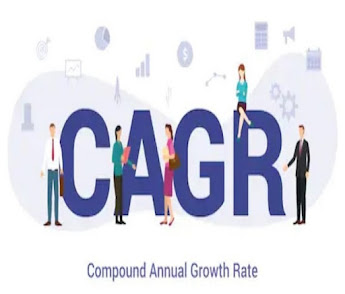By definition, Compounded Annualized Growth Rate (CAGR) is per annual return
compounded annually and used for calculating the return over a one year period.
For example, if the return in any particular scheme of a mutual
fund or stock for the last 5 years is 12% CAGR, which means if Rs. 1000 had been invested 5 years
back, now its value became Rs. 1762. However, the misconception among the investors is that
the growth of 1000 to 1762 has happened in linear fashion i.e. every year the return was generated @12% p.a. whereas actually, CAGR does not indicate the growth of funds
in a straight line manner like FD.
In reality, per annum growth could be
much higher, lower, or around 12% in any of the periods in between during the investment phase. This also means the growth rate could
be positive as well negative in some of the years and even than 5 years CAGR could be
12%. Here investor fails to understand this fluctuation (volatility) in market-linked instruments and believe that equity investment has high potential to deliver but
ignore the risk of getting a negative return or subdue return during interim
years.
Most investors don't mentally prepared to get such high volatility/fluctuation in investment returns on day to day basis and therefore failed to stick with a particular scheme if they don't see positive returns for a prolonged period of time and prefer to get out of the scheme even if getting loss.
You can see from the below mentioned seven examples, rate of return is the same which is 12% CAGR for 5 years, but the fluctuation on year on year basis is
drastically different and the risk associated with a negative return is always
ignored by the investor. Although in the long-run equity market always return back to
its mean average despite volatile fluctuations.
| Year |
Principal |
Rate |
Interest |
Total |
| 1 |
1000 |
12% |
120 |
1120 |
| 2 |
1120 |
12% |
134 |
1254 |
| 3 |
1254 |
12% |
151 |
1405 |
| 4 |
1405 |
12% |
169 |
1574 |
| 5 |
1574 |
12% |
189 |
1762 |
| Year |
Principal |
Rate |
Interest |
Total |
| 1 |
1000 |
-40% |
-400 |
600 |
| 2 |
600 |
27% |
164 |
764 |
| 3 |
764 |
32% |
245 |
1009 |
| 4 |
1009 |
42% |
424 |
1433 |
| 5 |
1433 |
23% |
330 |
1762 |
| Year |
Principal |
Rate |
Interest |
Total |
| 1 |
1000 |
4% |
40 |
1040 |
| 2 |
1040 |
-25% |
-260 |
780 |
| 3 |
780 |
48% |
374 |
1154 |
| 4 |
1154 |
29% |
335 |
1489 |
| 5 |
1489 |
18% |
273 |
1762 |
| Year |
Principal |
Rate |
Interest |
Total |
| 1 |
1000 |
18% |
180 |
1180 |
| 2 |
1180 |
27% |
319 |
1499 |
| 3 |
1499 |
-20% |
-300 |
1199 |
| 4 |
1199 |
30% |
360 |
1559 |
| 5 |
1559 |
13% |
203 |
1762 |
| Year |
Principal |
Rate |
Interest |
Total |
| 1 |
1000 |
19% |
188 |
1188 |
| 2 |
1188 |
0% |
0 |
1188 |
| 3 |
1188 |
-10% |
-119 |
1069 |
| 4 |
1069 |
-30% |
-321 |
748 |
| 5 |
748 |
136% |
1014 |
1762 |
| Year |
Principal |
Rate |
Interest |
Total |
| 1 |
1000 |
10% |
100 |
1100 |
| 2 |
1100 |
15% |
165 |
1265 |
| 3 |
1265 |
25% |
316 |
1581 |
| 4 |
1581 |
35% |
553 |
2135 |
| 5 |
2135 |
-17% |
-373 |
1762 |
| Year |
Principal |
Rate |
Interest |
Total |
| 1 |
1000 |
8% |
80 |
1080 |
| 2 |
1080 |
10% |
108 |
1188 |
| 3 |
1188 |
12% |
143 |
1331 |
| 4 |
1331 |
14% |
186 |
1517 |
| 5 |
1517 |
16% |
245 |
1762 |
In all the above cases, we get the same result - an investment of Rs. 1000 and getting the maturity of Rs. 1762 after 5 years at 12% CAGR. What makes the difference in the process of achieving that result. that investors need to understand before making the decision just only on a return parameter!

No comments:
Post a Comment